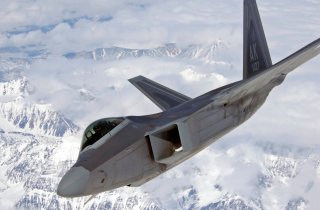Lookout: The F-22 Raptor Could Be Getting Laser Weapons
Why use a laser instead of a bullet, shell, or missile?
At the turn of the twenty-first century, the chemically powered Tactical High-Energy Laser, jointly developed with Israel, proved effective in tests at shooting down dozens of Katyusha rockets, artillery shells and mortar rounds. However, the system, which resembled a large searchlight projector, was rejected as being too bulky, expensive and impractical, as each laser battery involved six bus-sized trailers of equipment.
However, the U.S. Army is has since been pursuing a ground-based version of HELLADS. The ten-kilowatt HEL-Mobile Demonstrator mounted on an Army HEMTT truck—the largest type in service—proved effective in trials at shooting down drones and sixty-millimeter mortar rounds. A more powerful sixty-kilowatt combined fiber laser known as the HEL-MTT was tested in March 2017. This device brings together multiple laser beams via fiber-optic cables, making the weapon scalable by adding additional cables. Eventually, the Army hopes to ramp up to a hundred-kilowatt laser, which might guarantee timely destruction of heavier projectiles.
Separately, in May 2017 the Army tested a five-kilowatt drone-killing laser mounted on an eight-wheeled Stryker armored personnel carrier in an air-defense trial at Fort Sill. The mobile armored laser shot down twenty-one of twenty-three drone targets in what was billed as a realistic exercise. A powered-up ten-kilowatt version, with greater range and hitting power, will be tested in November.
Numerous earlier attempts at developing laser weapons such as the THEL and ABL lasers failed, not because they couldn’t destroy their targets, but because they were too bulky and short range to be practical. However, contemporary programs appear to be addressing the problems of size and mobility, and several are likely to enter service early in the next decade—with similar systems entering service in Russia and China.
Although laser weapons may see some offensive applications, it appears their primary function will remain defensive: countering the growing threat posed by long-range missiles and drones, as well as reducing the mayhem caused by old-fashioned mortars and rocket artillery.
Sébastien Roblin holds a master’s degree in conflict resolution from Georgetown University and served as a university instructor for the Peace Corps in China. He has also worked in education, editing and refugee resettlement in France and the United States. He currently writes on security and military history for War Is Boring. This article first appeared several years ago.
Image: Wikipedia.

